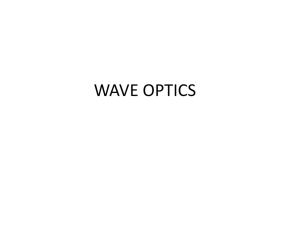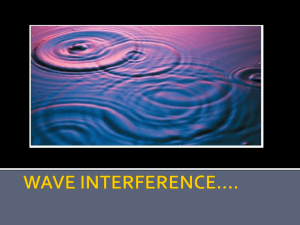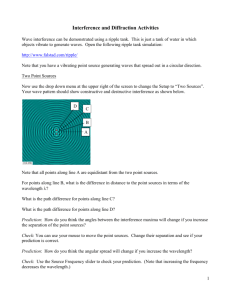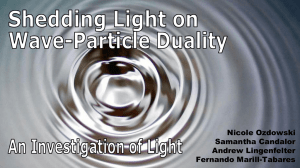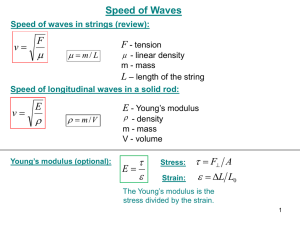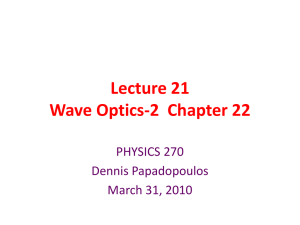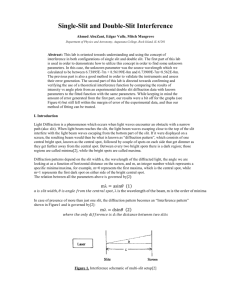W11Physics1CLec27Bfkw
advertisement
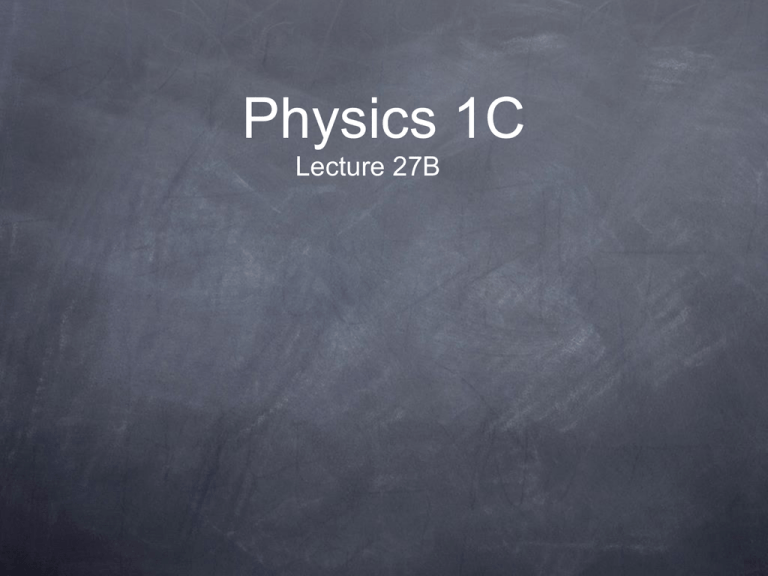
Physics 1C Lecture 27B Interference in Thin Films Interference in soap bubbles. The colors are due to interference between light rays reflected from the front and back surfaces of the thin film of soap making the bubble. The color depends on the thickness of the film. Black appears where the film is thinnest. Red appears where the film is thickest. Interference in Thin Films With light incident on a thin film we have to examine two light rays that follow the same path: Ray 1 (in air) reflects off the film surface and undergoes a phase change of 180o compared to the incident ray. Ray 2 (in air) refracts at the film surface and then reflects off of Surface B (film to air) with no phase change compared to the incident wave. Interference in Thin Films In addition, Ray 2 travels a distance t down and and a distance t up (for a total distance 2t). Since the extra distance that Ray 2 travels is in the film medium, its wavelength will be different then in air. The wavelength of light, λn, in a medium with index of refraction n is: n where λ is wavelength of light in a vacuum (air?). n Interference in Thin Films In order for constructive interference to occur, the two rays must be in phase. This means that the difference in path length and phase must combine to m(λ / n), where m = 0, ±1, ±2... The difference in path is: 2t and the difference in phase is: 180 o Combining all of these gives us: 1 1 2nt m 2 2t m 2n n 1 2 n Constructive Interference for 1 phase change. Disclaimer • We ignored the angle in this discussion. I.e. we assumed the light enters orthogonal to the surface of the film. Diffraction Patterns The diffraction pattern appears on a screen when light passes through a narrow vertical slit. The pattern consists of a broad, intense central band and a series of less intense and narrower side bands. A diffraction pattern is just another interference pattern. Diffraction Patterns Diffraction pattern of a penny, taken with the penny midway between screen and source. The shadow of a penny displays bright and dark rings of a diffraction pattern. The bright center spot is called the Arago bright spot. The bright spot is explained by the wave theory of light. Waves that diffract on the edges of the penny all travel the same distance to the center. The center is a point of constructive interference Single Slit Experiment A single slit of a finite width placed between a distant light source and a screen produces a diffraction pattern (similar to a double slit experiment). It will have a broad, intense central band. The central band will be flanked by a series of narrower, less intense secondary bands (secondary maxima) that form the diffraction pattern. Single Slit Experiment The bright central band of the pattern will also be flanked by a series of dark bands (minima). In general, destructive interference occurs for a single slit of width, a, when: m sin a where m is ±1, ±2, ±3... You can observe the first minimum at the angle: sin a 1 Single Slit Experiment The cause of single slit interference is path length difference (just like double slit interference). In the single slit case, each portion of the slit acts as a source of waves. The light from one portion of the slit can interfere with light from another portion of the slit. We can divide up a in 2,4,6,… portions, and then have rays from the same position in neighboring portions interfere to get the m = 1,2,3,… minimum We will again assume L>>a to use the approximation: y sin L Single Slit Interference Example Light of wavelength 750nm passes through a slit 1.00μm wide. How wide is the central maximum in centimeters, in a Fraunhofer diffraction pattern on a screen 20.0cm away? w Answer First, you must define a coordinate system. The center of the central maximum is considered y = 0. Single Slit Interference Answer We can easily calculate the angle θ from the centerline to the first minimum, m = 1, by: m sin a 7 1 7.5 10 m sin 0.75 6 1.0 10 m sin 0.75 48.6 1 distance from the centerline to the first We can find the minimum by taking: y tan L y Ltan 20 cmtan48.6 22.7 cm But since this is only half the central maximum width, we must double it; so that: w = 2y = 45.4cm. Concept Question Upon reflection, light undergoes a 180o phase change: A) If the incident medium has the lower index of refraction B) Never C) Whenever the incident angle is less than the critical angle D) Always E) If the incident medium has the higher index of refraction (N.B.: Incident medium is the medium where both incident and reflected waves are propagating) Resolution The ability of an optical system to distinguish between closely spaced objects is limited due to the wave nature of light. Aside: Two independent sources of light are not coherent. I.e. the light form them does not interfere with each other. Since we are looking through an opening, diffraction can occur where the images consist of bright central regions flanked by weaker bright and dark rings. If the two sources are separated so that their central maxima do not overlap, their images are said to be resolved. Resolution The limiting condition for resolution is called Rayleigh’s Criterion When the central maximum of one image falls on the first minimum of another image, the images are said to be just resolved. The images are just resolved if their angular separation satisfies Rayleigh’s criterion. Resolution If viewed through a slit of width, a, and applying Rayleigh’s criterion, the limiting angle of resolution is: For the images to be resolved, the angle subtended by the two sources at the slit must be greater than θmin. For a circular opening of diameter D: Concept Question Suppose you are observing a binary star with a telescope and having difficulty resolving the two stars. You decide to use a colored filter to maximize the resolution. What color filter should you choose? 400nm A) Blue. B) Green. C) Yellow. 700nm D) Red. A filter of given color transmits only that color of light. Radio Astronomy Astronomy through Interferometry All of these use correlated measurements from more than one telescope in order to increase their effective aperture, and thus beat the diffraction limit of the individual telescopes. Crude Benefit Analysis • Fully instrumented (and thus smaller aperture) single telescope allows viewing of dimmer objects. • Interferometry is similar to having a larger instrument but with sparsely instrumented sensitive area. • Better angular resolution • Dim objects can only be resolved at the angular resolution of the individual telescopes, not the array. • Resolution generally differs for different directions in field of view. Challenge in Interferometry • The signals from the different telescopes need to be made to interfere with each other. • This requires a measurement of both the phase and amplitude of the incoming signals. • Phase is obtained by timing of peak amplitude. • Synchronized atomic clocks • Sufficiently accurate phase measurements can only be done with long wavelength EM waves. • Accordingly, this technique is only used in radiowave astronomy. • The longer the wavelength, the easier it is to measure the phase. Concept Question • What’s the limit for resolving distant objects via earth based astronomy? • A) engineering limit of how small an aperture telescope can be constructed. • B) engineering limit of how large an aperture telescope can be constructed. • C) roughly speaking, the diameter of the earth EVN largest distance interferometry Radio telescopes throughout the world do interferometry together. VLA in New Mexico & Satellite HALCA HALCA has only 8m diameter Comparing resolution of a Quasar with VLA and a combo of VLA and HALCA Concept Question Light of wavelength λ1 illuminates a double slit, and interference fringes are observed on a screen behind the slits. When the wavelength is changed to λ2, the fringes are closer together. How large is λ2 relative to λ1? A) λ2 < λ1. B) λ2 > λ1. C) λ2 = λ1 y bright m L (m 0, 1, 2 d ) D) There is no way to tell how λ1 and λ2 compare with this experiment as changing the wavelength will never affect distance between the resulting interference fringes. For Next Time (FNT) Finish reading Chapter 27 Continue working on homework for Chapter 27


